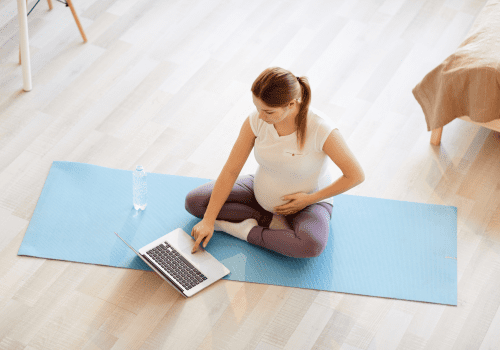
Congratulations, you have found out you’re expecting a baby and now have a free pass to no longer exercise! FALSE. I wish that statement was true, but it cannot be further from the truth. It is not the time to pick up a new high intensity workout, but choosing a suitable exercise routine and modifying movements to accommodate for your stage in pregnancy are good for both you and your little one. The American College of Obstetrics and Gynecology (ACOG) recommends, “Regular physical activity during pregnancy improved or maintains physical fitness, helps with weight management, reduces the risk of gestational diabetes in obese women, and enhances psychologic well-being.” Regular physical exercise has many health benefits during pregnancy and also helps to prepare your body for childbirth. It is important to consult with your healthcare professional to make sure the exercise routine is not harmful for you or your baby.
Don’t exercise if…
Aerobic exercise during pregnancy is not safe if you have any of the following medical conditions:
- Significant heart or lung disease
- An incompetent cervix
- You are carrying more than one baby and are at risk for premature labor
- Persistent second or third-trimester bleeding
- Placenta previa past 26 weeks of pregnancy
- Ruptured membranes
- Preeclampsia (pregnancy-induced hypertension)
Warning signs to stop exercising and call your doctor:
- Vaginal Bleeding
- Dyspnea (difficult or labored breathing) prior to exertion
- Dizziness
- Headache
- Chest pain
- Muscle weakness
- Calf pain or swelling
- Preterm labor
- Decreased fetal movement
- Amniotic fluid leakage
The Centers for Disease Control and Prevention recommend 150 minutes of moderate-intensity aerobic activity every week. Moderate-intensity moving is enough to raise your heart rate and start sweating. Some examples of exercise include swimming, brisk walking, gardening, stationary bike, elliptical, and prenatal yoga. If you are new to exercise you may consider gradually increasing your activity by five minutes each week until you are able to stay active for 30-minute increments. ACOG further recommends, “Although frequently prescribed, bed rest is only rarely indicated and, in most cases, allowing ambulation should be considered.” Remember that exercise doesn’t have to be strenuous to be beneficial.
Exercise tips when you’re pregnant:
- Always warm up before exercising, and cool down afterwards.
- Try to keep active on a daily basis; 30 minutes of walking each day can be enough, but if you can’t manage that, any amount is better than nothing. If you haven’t been active or are overweight, start with 3-4 days spread across the week.
- Drink plenty of water and other fluids.
- If you go to exercise classes, make sure your teacher is properly qualified, and knows you’re pregnant and how many weeks pregnant you are.
- Walking is a great exercise — it is a moderate aerobic activity but will have minimal stress on your joints. Other good choices are swimming and cycling on a stationary bike.
- Performing standing hip circles and frequent crawling movements are very beneficial.
- Avoid semi-reclined, lounging, positions as it promotes poor baby positioning.
Exercises for a fitter pregnancy
If you are pregnant, try to fit the exercises/stretches listed below into your daily routine in addition to aerobic activity. They will strengthen your muscles so that you can carry the extra weight of pregnancy. They’ll also make joints stronger, improve circulation, ease backache and generally help you feel well.
Cat/Box Pose –
As your baby gets bigger, you may find that the hollow in your lower back increases and this can give you backache. These exercises strengthen stomach (abdominal) muscles and ease backache, which can be a problem in pregnancy:
- Start in a box position (on all fours) with knees under hips, hands under shoulders, with fingers facing forward and abdominals lifted to keep your back straight.
- Pull in your stomach muscles and raise your back up towards the ceiling, curling the trunk and allowing your head to relax gently forward. Begin arching back and letting neck/head release. Turn gaze between legs towards belly.
- Hold for a few seconds then slowly return to the box position.
- Take care not to hollow your back; it should always return to a straight/neutral position. Do this slowly and rhythmically 10 times, making your muscles work hard and moving your back carefully. Only move your back as far as you can comfortably.


Child’s Pose –
- Begin on hands and knees, spread your knees wide apart making room for baby.
- Slowly lower your buttocks to your heels. Modified position you may rest your arms on pillows to elevate.
- Keep your arms long and extended, palms facing down. Press back slightly with your hands to keep your buttocks in contact with your heels. Lengthen from your hips to your armpits, and then extend even further through your fingertips. Breathe and allow tension in your shoulders, arms, and back melt away.


Cobbler’s stretch –
Shown with support. You can do without knee support if possible.
Gentle hold and stretch should be felt.

Figure 4 seated stretch –
Sit up nice and tall.
Hold for 30 seconds and perform 2-3 times with each leg.

Triangle Pose –
- Stand with feet wide, right foot turned out and right heel aligned with arch of left foot; raise arms to shoulder height and out to sides, palms facing the floor.
- Bend forward from the hips over right leg, placing your right hand on your shin or ankle, as you extend your left arm toward the ceiling, palm facing forward; turn head to look up at ceiling Hold for 10-30 seconds. Repeat opposite side.

Plié –
- Stand parallel to the back of a sturdy chair with the hand closest to the chair resting on it, feet parallel and hip distance apart.
- With your toes and knees turned out to 45 degrees, pull your belly button up and in. Bend your knees, lowering your torso as low as possible while keeping your back straight. Straighten your legs to return to starting position Repeat for repetitions.

Clam Shells –
- Lie on your left side, supporting your head with your forearm, and both legs bent at a 45 degree angle. Place your opposite arm on the floor for stability.
- Keep your ankles and knees together,
- Slowly lift the top leg, separating the knees. Hold for 5 seconds and repeat 5 times.
- Switch sides and repeat. You may add a resistance band around the thighs to progress the exercise.

Stop immediately if any of the above exercises are painful and talk to your healthcare team. There are many options that make it possible to have a pain-free pregnancy. Your body is going through a lot of changes physically in a brief period and you may be feeling increased aches and pains. I am here to help. I am always honored to have the opportunity to work with you throughout your pregnancy and provide you individualized tips and exercises. Pregnancy isn’t always sexy and can have its road bumps, but you do not have to accept pain. It is a short ten months and you will be holding baby before you know it! Keep your head up and take each day at a time. You are made to do this, mama!



